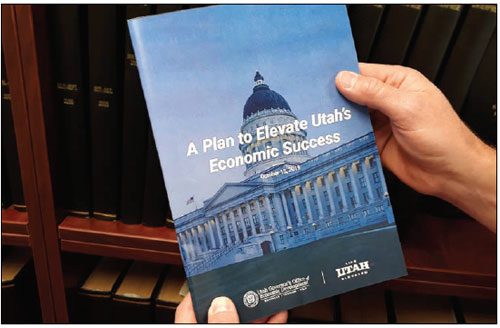Brice Wallace
The captain of “Team Utah” has unveiled a new playbook.
The team name often has been applied to organizations working to boost Utah’s economic development, and the Governor’s Office of Economic Development — the team’s captain, so to speak — last week released a strategic plan designed to maintain and expand on Utah’s winning economic track record.{mprestriction ids="1,3"}
The “Plan to Elevate Utah’s Economic Success” is the result of four months of work after the Legislature charged GOED with compiling a comprehensive review of state government’s economic development activities and recommending changes. GOED got help from an Economic Development Strategic Plan Committee of about two dozen people, survey input from more than 430 Utah industry leaders, input and recommendations from 17 subcommittees, and it contracted with the nonprofit Center for Regional Economic Competitiveness (CREC) to get expert opinion and prepare the report.
Kenneth E. Poole, president and CEO of CREC, said the plan is “a terrific roadmap for Utah moving forward” during a meeting of the Economic Development and Workforce Services Interim Committee.
“Economic development today, and it’s always been, is around fostering change in our communities and preparing for the future, and we shouldn’t sit back on our laurels and ignore the work that we need to be doing in economic development,” he said.
The report notes that not every part of Utah is benefiting from the state’s economic success, that Utah must prepare for possible economic disruption driven by changes in technology and the increased adoption of automation, and prepare for a potential economic downturn that some economists are predicting.
The plan calls for broader and deeper teamwork — often called “collaboration” or “partnerships” in economic development-speak — among all levels of government, with educational institutions and between the public and private sectors.
“Public-private partnerships, I think, is something that Utah has not done well yet. … Public-private partnerships is a tremendous opportunity,” Val Hale, GOED’s executive director, told the Economic Development and Workforce Services Interim Committee.
The plan encourages communication, cooperation and coordination between state and local governments and organizations in the private sector. “At the heart of its efforts, Utah agencies — state, local, nonprofit and even private-sector — must work in concert,” the report states.
“Our approach is to pursue economic development in Utah as a team sport, beginning with improvements in communication and collaboration across state agencies and among state and local partner organizations. The plan specifically identifies roles for many state agencies supporting the state’s economic development efforts, highlighting GOED’s role as the captain for ‘Team Utah’ but calls out important roles for other agencies to promote key industries, manage the needed infrastructure and ensure the state has the talent to compete successfully in a global economy.”
Among the plan’s other recommendations are helping rural Utah by streamlining GOED’s 10 existing rural-focused programs into one focusing on entrepreneurship, developing Utah-specific training for local economic development officials, basing corporate incentive-related jobs on industry rather than local community wage levels, and eliminating the requirement that Utah award incentives to companies only if Utah is competing with other states for a project.
“It seems a little dysfunctional that if a [Utah] company wants to grow in Utah, we ought to not force them to go look elsewhere where they might find that there’s actually an incentive that would work better for them than what we could offer in Utah,” said GOED board chairman Jerry Oldroyd.
The plan features a statewide economic development vision statement and identifies four policy “pillars,” each with goals and actions:
• Strategic industry advancement, featuring “investment in industries that create a public benefit through human and physical capital improvements in urban and rural Utah.”
• Innovation and entrepreneurship, featuring support for “the creation and growth of high-impact, future-forward Utah businesses and products for the global market.”
• Talent development by aligning industry and education “to continue producing a highly skilled, world-class workforce.”
• “Uniquely Utah,” capitalizing on “Utah’s natural environment, outdoor recreation and sports, and unique heritage and arts to attract workers and build the state’s tourism and film economies.”
After hearing GOED officials’ presentation, a few legislators stressed that Utah needs to look at the broader impacts of economic development, including complications found in pollution, traffic gridlock and the affordability of housing.
The plan is at https://business.utah.gov/news/2019-economic-development-strategic-plan/.{/mprestriction}








